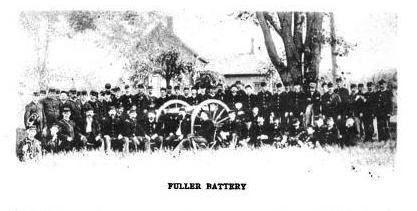 An 1855 lithograph shows the town of Bellows Falls looking westward from Table Rock on Fall Mountain, a popular vantage point on the New Hampshire side of the Connecticut River. The Island is in the foreground, with the Vermont Valley Railroad approaching from the south (left), the Cheshire Railroad from the east (double track covered bridge in lower right), and the Rutland and Burlington Railroad from the north (right).
An 1855 lithograph shows the town of Bellows Falls looking westward from Table Rock on Fall Mountain, a popular vantage point on the New Hampshire side of the Connecticut River. The Island is in the foreground, with the Vermont Valley Railroad approaching from the south (left), the Cheshire Railroad from the east (double track covered bridge in lower right), and the Rutland and Burlington Railroad from the north (right).
Levi Knight Fuller had his tenth birthday in the year 1851; it was the same year the Vermont Valley Railroad Company drove its landmark 278-foot-long tunnel underneath the town center of Bellows Falls, Vermont. Levi’s family had moved from Westmoreland, New Hampshire, where he was born in 1841, to Vermont’s Windham County when the lad was 4 years old. Some accounts mention the family as relocating to Bellows Falls, but others, which seem more definitive – one source cites Fuller as a co-author, which is ample witness – put the family in Westminster, a smaller town just 5 miles down the road. Another source phrases it as an eventuality: the family ended up in Bellows Falls after their initial venture into the area in 1845.
 The northern portal of the Vermont Valley Railroad Company’s 1851 tunnel beneath the center of Bellow Falls, the tracks turning toward Brattleboro, 24 miles south on the west bank of the Connecticut River. Above this tunnel, out of sight, are the roads and brick and wood-frame buildings of the downtown business district.
The northern portal of the Vermont Valley Railroad Company’s 1851 tunnel beneath the center of Bellow Falls, the tracks turning toward Brattleboro, 24 miles south on the west bank of the Connecticut River. Above this tunnel, out of sight, are the roads and brick and wood-frame buildings of the downtown business district.
The Vermont Valley Railroad Co. (chartered Nov. 8, 1848; amended Oct. 6, 1849) was the third to reach Bellows Falls, fast becoming a booming industrial and transportation hub on the Connecticut River. The company had built its 24-mile-long right-of-way on the west bank of the Connecticut River starting north from Brattleboro in 1850; it connected the Vermont and Massachusetts Railroad there with the two roads already stationed at the Falls: the Cheshire (connecting with Boston) and the Rutland and Burlington. The unusual tunnel under the downtown was necessitated by the Vermont Valley’s approach from the west side of the river to what was known as “The Island”, a section of land created when the Bellows Falls Canal was opened in 1802, bypassing the Great Falls on the Connecticut. The island was the site of the railroads’ junctions, the switching yards, engine houses, and the accompanying passenger and freight stations and maintenance buildings. Levi Fuller would eventually spend the rest of his mature days residing in Brattleboro near the southern terminus of the VVRR, but as a young farm boy growing up near the iron rails approaching the interchange through the fertile bottomlands of Westminster, it must have been a wondrous time.
 The Bellows Falls railroad tunnel seen from the south portal, diving under the center of Bellows Falls and heading toward the bridge over the canal and the junction on the Island.
The Bellows Falls railroad tunnel seen from the south portal, diving under the center of Bellows Falls and heading toward the bridge over the canal and the junction on the Island.
Young Levi showed a proclivity for mechanical tinkering and a thirst for knowledge at a very early age. In his own words, taken from a speech he delivered late in life (1893) entitled “Vermont In a Century of Invention”, he recalled “a small steam engine which he made when a boy of 10, using for its cylinder the brass tube of a small spy-glass. Work upon this, he said, determined the course of his future life.” The type of steam engine model he built is unknown – he describes the brass tube’s function as the cylinder, whether vertical or horizontal, and of the boiler and valving we know nothing, but he had plenty of inspiration nearby in the form of mills, locomotives, and other industrial and agricultural equipment. This set him on the path he would avidly pursue for the rest of his days.
 A modern-day solid brass oscillating steam engine miniature; basic yet elegant. Levi Fuller’s first model would have been simpler and built of found materials, but showed his early bent for mechanical engineering.
A modern-day solid brass oscillating steam engine miniature; basic yet elegant. Levi Fuller’s first model would have been simpler and built of found materials, but showed his early bent for mechanical engineering.
At the tender age of 13, Levi Fuller left home and headed south to Brattleboro, where he found employment at a printing establishment, learned telegraphy, attended the Brattleboro High School, and continued his self-studies and mechanical pursuits. At sixteen years old he built another steam engine with a new and novel valve arrangement of his own contrivance; he exhibited the machine at the Windham County Agricultural Society’s Annual Fair. His invention attracted much attention and the Society’s judges awarded him a premium for his accomplishment; this fueled his desire for greater scientific understanding and technical proficiency and he left Brattleboro for Boston to apprentice with a mechanical engineering firm. It seems the year would have been 1857; one source indicates the year as 1856, but this remains to be pinpointed. Levi Knight Fuller was well on his way to finding his calling and following his muse.








